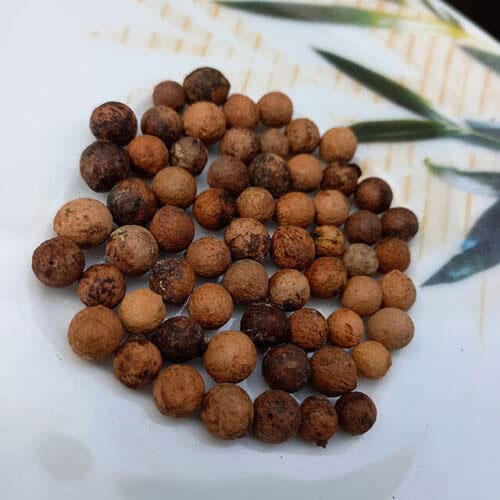Total Number of seeds: 20
White Sandalwood Seeds (Santalum album) are prized for their ability to grow into highly valuable aromatic trees, known for producing fragrant heartwood and essential oil. These seeds are ideal for those planning afforestation, agroforestry, or long-term investment plantations. The white sandalwood tree is slow-growing but offers incredible commercial value due to its aromatic wood used in perfumes, Ayurveda, and pooja products. Grow your own legacy tree with these premium seeds.
Variety Name: White Sandalwood (Santalum album)
Type of Seed: Forestry / Tree Seeds
Germination Time: 20–45 days
Sunlight Requirements: Full sunlight
Growing Locations: Open land, farm boundary, agroforestry zones
Growing Season: Monsoon is ideal; can be started in mild climates year-round
Seed Sowing Depth: 1–1.5 cm
Ideal Climate: Tropical and semi-tropical regions
Plant Height: Can reach 12–15 meters in height over time
Fertilizer Needs: Organic manure or farmyard compost twice a year
Life Span: Long-term perennial (30–50 years lifespan)
Ideal Growing Temperature: 20°C to 38°C
Harvesting Time: 10–15 years for heartwood harvesting
Maintenance Required: Moderate to high in early stages
Watering Frequency: Twice a week in the initial 2 years
Ideal Grow Bag Size: For nursery stage – 6x8 inch polybag


White Sandalwood grows best when sown at the onset of the monsoon season (June–July) for natural rain-fed support. In southern India and the Deccan belt, it can be cultivated round the year with adequate irrigation. Avoid sowing in peak summer or extreme cold zones.
Start seeds in a polybag or seedling tray with rich red soil and sand mix. Soak seeds overnight before planting. Maintain partial shade until sprouting. After 3–4 months, saplings can be transplanted into the main field with a host plant (like pigeon pea) for better survival and growth.
Preparation: Soak seeds for 24 hours in lukewarm water
Sowing: Plant at 1 cm depth in well-drained nursery soil
Watering: Mist gently daily until sprouting
Germination: 20 to 45 days
Transplanting: After 3–4 months when plant is 6 inches tall
Sunlight: Requires full sun for at least 6–8 hours daily
Soil: Sandy loam to red soil is best; good drainage is essential
Fertilization: Apply cow dung or compost every 4 months
Pruning: Not needed in early stages
Support and Spacing: Maintain 8–10 ft spacing per plant
Pest Control: Neem cake and organic pesticides for early growth
Disease Prevention: Ensure airflow and avoid water stagnation
Mulching: Helps retain moisture and prevents weed growth
Harvesting: Ready in 10–15 years when heartwood matures
1. Apply Nutrient-Rich Fertilizers
When your plants begin flowering, use nutrient-rich fertilizers like Organic Bone Meal Powder or Vermicompost. This helps in boosting the bloom and enhances overall yield.
2. Use Organic Fertilizers
Feed your plants with organic fertilizers such as Cow Dung Manure or Neem Cake. Organic options promote healthy soil life.
3. Regular Feeding
Apply fertilizers every 20-25 days to ensure plants receive a steady supply of nutrients. Choose from various options like Cocopeat Compost for moisture retention.
Highly aromatic heartwood with global commercial value
Used in Ayurvedic medicine, pooja, perfumes, incense, and essential oils
Long lifespan and evergreen tree
Rare and protected species ideal for legacy plantation
Can grow in dry and moderate rainfall zones
💰 Excellent long-term return for farmers and landowners
🌿 Used in rituals, medicine, and skincare
🌱 Improves farm biodiversity as part of agroforestry
🌳 Adds shade and greenery to the environment
🧘 Popular in spiritual and therapeutic products
Needs a host plant like red gram or legumes for proper root development
Protect young saplings from grazing animals
Avoid heavy clay soils or water-logged land
Needs proper spacing to grow full crown
May require fencing in the early years for protection
Slow Germination: Soak seeds properly before sowing
Poor Growth: Ensure presence of host plant and good drainage
Pest Attack (early stage): Use neem oil spray
Drying Leaves: Water moderately and mulch base
Seed Rot: Use raised nursery beds and avoid overwatering
Sandal, Chandan, Srigandha, Safed Chandan, Santalum album, Sandal Tree, Chandanam, Gandhamaram, Chandanachettu, Sandalwood Tree
Sign in now to receive a 5% instant discount on your first order when using code WELCOME. Begin your organic journey today!
By logging in, you're agreeing to our Terms of Service and Privacy Policy.
Manoj
5 mein se sirf 2 seeds germinate hue par dono bahut healthy grow kiya.
Karan
Germination thoda slow tha—after 6 weeks ek ek sprout nikalne laga, patience zaroori hai.
Ritu
Soaked seeds overnight aur sandy soil mein sow kiya, 8th week tak sprouts aa gaye.
Alok
Sandalwood saplings bahut slow grow karte hain, par leaves bright green hue.
Harsha
germination kaafi time liya but result strong aur healthy tha.
Varun
Excellent packaging and detailed info—germination guide helpful tha.
Ashok
Sprouting ke baad transplant easy tha, lekin moisture ka dhyan rakhna zaroori hai.
Divya
seeds ka germination uneven tha but jo nikle wo strong sprouts the.
Kavita
Scarification kiya tha pehle—germination 7th week mein start hua, kaafi natural feel aaya.
Nisha
Slow growers hain but worth it—fragrance aur leaf structure unique tha.